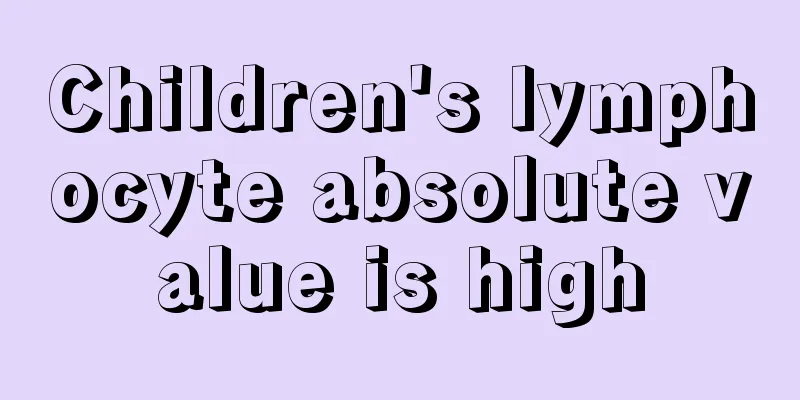Children's lymphocyte absolute value is high

|
Because children are young, their body resistance is relatively weak, and they have no ability to protect themselves, so they are very easy to catch diseases such as colds or diarrhea. When they go to the hospital for examination and tests, the test report sometimes will show that the absolute value of children's lymphocytes is high. Many parents become nervous when they see this and don't know what is going on. In fact, don’t be nervous when you see this situation, because it is a normal pathological reaction. Let me briefly introduce some knowledge in this regard below. There are several reference values of the baby's blood routine that are not within the normal rangeLymphocyte percentage 53.1 20-40 % Monocyte percentage 10.6 3-8 % Neutrophil percentage 30.6 50-70 Absolute value of lymphocytes 4.50 0.8-4 Absolute value of monocytes: 0.9, 0.12-0.8 The lymphocyte ratio of 70% is not too high, because lymphocytes and neutrophils are both types of white blood cells, and this percentage is the percentage of these two cells in white blood cells. If the lymphocyte ratio is high, the neutrophil ratio is also low. Although generally speaking, a high lymphocyte ratio indicates the possibility of viral infection, it is not always caused by viral infection. Since you know that the child has no symptoms of discomfort, there is no need to worry too much. Children are the least likely to pretend. Once they feel uncomfortable, they will show it immediately, right?Look at the absolute value of neutrophils. If it is lower than the normal value, it indicates a viral infection. The lower the absolute value of neutrophils, the more severe the viral infection. If it is higher than normal, it indicates a bacterial infection. The total white blood cell count in the body is not too high, but the absolute value of neutrophils is very high, indicating that the child's fever will become more and more severe. This form states: the child has a viral infection, low white blood cell count, low neutrophil count, and the fever has ended. The blood count of infants and young children is higher than that of adults, so we cannot simply judge that the child is "sick" based on the "high blood count". Instead, we need to see to what extent, because infants and young children have their own independent normal physiological judgment standards, which cannot be judged by adult standards. Many people who are not medical professionals or have not worked in pediatrics often make this mistake! If it is "really high", then most of the time it is "infection", and the most common "tonsillitis", pharyngitis, colds, etc. are all infectious diseases, which will cause the blood count to be high. There is a misunderstanding: high blood count is a "symptom" rather than a disease. 1. Leukemia will cause "abnormal increase in white blood cell count", not "increased white blood cell count causes leukemia"; 2. For people with leukemia, the white blood cell count is "increased by more than 10 times", not "slightly increased". |
<<: There is a depression on the back of the baby's head. What's going on?
>>: What should I do if my baby has a bump on the back of his head?
Recommend
How to treat rashes in infants
Parents are more worried about rashes in young ch...
What to do if a four-year-old keeps coughing
Coughing is very common in children, especially i...
What to do if infants and young children are zinc deficient
Zinc deficiency is a very common symptom in child...
What causes children to sweat at night?
Sweating is a common physiological phenomenon of ...
Can HPV16 be passed on to children?
HPV16 is a highly contagious virus, and the main ...
What should I do if my baby has a fever during the confinement period?
Mothers will go through a difficult period of con...
What should a three-month-old baby with anemia eat?
As soon as the baby is anemic, parents will be ve...
What to do if your child has red bloodshot eyes?
What's going on with the red bloodshot in my ...
Is it serious if the inside of a newborn's lips turn purple?
Many parents are very concerned about their child...
What should I do if my child doesn’t like to communicate?
Communication is a way of conveying information b...
The child has repeated fever and blisters at the mouth
Children have poor body resistance and are prone ...
Six-year-old child's front teeth are growing inside
A six-year-old child has a tooth growing inside h...
Treatment of eczema on the face of a 1-year-old baby
Problems like eczema are prone to occur in a humi...
What's wrong with the red spots on the corners of my baby's mouth?
A baby's health is often very fragile due to ...
Why is it that one of my child's testicles is larger than the other?
We all know that the important function of testic...









